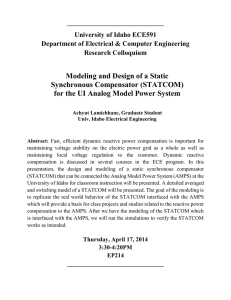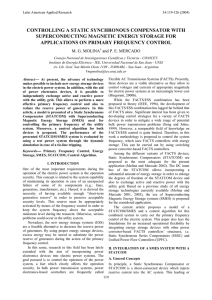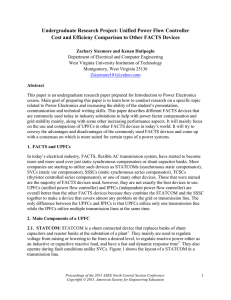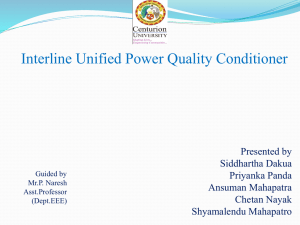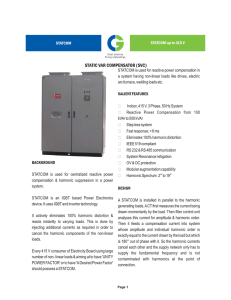UNIT IV- Emerging FACTS Controllers SriVidya College of
advertisement
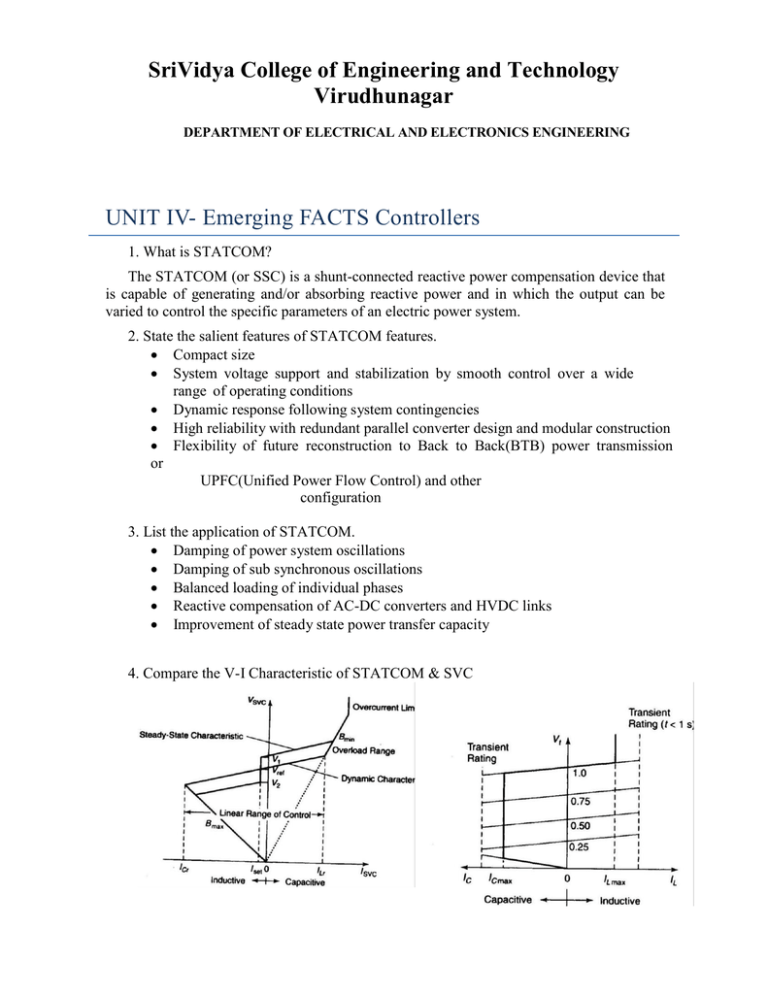
WWW.VIDYARTHIPLUS.COM SriVidya College of Engineering and Technology Virudhunagar DEPARTMENT OF ELECTRICAL AND ELECTRONICS ENGINEERING UNIT IV- Emerging FACTS Controllers 1. What is STATCOM? The STATCOM (or SSC) is a shunt-connected reactive power compensation device that is capable of generating and/or absorbing reactive power and in which the output can be varied to control the specific parameters of an electric power system. 2. State the salient features of STATCOM features. Compact size System voltage support and stabilization by smooth control over a wide range of operating conditions Dynamic response following system contingencies High reliability with redundant parallel converter design and modular construction Flexibility of future reconstruction to Back to Back(BTB) power transmission or UPFC(Unified Power Flow Control) and other configuration 3. List the application of STATCOM. Damping of power system oscillations Damping of sub synchronous oscillations Balanced loading of individual phases Reactive compensation of AC-DC converters and HVDC links Improvement of steady state power transfer capacity 4. Compare the V-I Characteristic of STATCOM & SVC WWW.VIDYARTHIPLUS.COM V+ TEAM WWW.VIDYARTHIPLUS.COM 5. How the reactive power compensation is done using STATCOM. A STATCOM is a controlled reactive power source. It provides the desired reactive power generation and absorption entirely by means of electronic processing of the voltage and current waveforms in a voltage source converter 6. List the modes of operation of STATCOM The STATCOM can be operated in two different modes: Voltage regulation mode under this mode it has 3 sub divisions. There are, Over excited mode of operation Under excited mode of operation Normal(floating) excited mode of operation Var control mode 7. Draw VI characteristics of STATCOM. 8. Compare STATCOM and SVC. The STATCOM has the ability to provide more capacitive reactive power during faults, or when the system voltage drops abnormally, compared to ordinary static var compensator. This is because the maximum capacitive reactive power generated by a STATCOM deceases linearly with system voltage, while that of the SVC is proportional to the square of the voltage. Also, the STATCOM has a faster response as it has no time delay associated with thyristor firing. Nevertheless, these advantages come at a higher price(about 20% more) 9. What are the function of STATCOM? WWW.VIDYARTHIPLUS.COM V+ TEAM WWW.VIDYARTHIPLUS.COM Dynamic voltage control in transmission and distribution systems. Power oscillation damping in power transmission systems Transient stability improvement Ability to control not only reactive power but, if needed, also active power (with a DC energy source available) 10. Define STATCOM. The STATCOM has been defined as per CIGRE/IEEE with following three operating scenarios. First component is static: based on solid state switching devices with no rotating components; Second component is Synchronous: Analogous to an ideal synchronous machine with 3 sinusoidal phase voltages at fundamental frequency; Third component is compensator: rendered with reactive compensation. 11. List the advantages/benefits of STATCOM. The STATCOM offers following advantages: Superior voltage supporting capability Fast response Large reactive power generation under low system voltage condition Less harmonics generation Smaller filter capacity Less space requirement 12. What is UPFC? The UPFC is a device which can control simultaneously all three parameters of line power flow(line impedence, voltage and phase angle).Such “new” FACTS device combines together the features of two “old” FACTS devices” the Static Synchronous Compensator(STATCOM) and the Static Synchronous Series Compensator (SSSC). It is proposed by Gyugyi in 1991. 13. What is role of dc link in UPFC? The real power is supplied from, or absorbed by, the DC energy storage device called dc link. 14. List the application of UPFC. Power flow control Power swing damping WWW.VIDYARTHIPLUS.COM V+ TEAM WWW.VIDYARTHIPLUS.COM Voltage dips compensation Fault Current Limiting 19. State the salient features of UPFC. The UPFC is versatile and multifunction power flow controller with capabilities of terminal voltage regulation , series line compensation and phase angle regulation Minimization of power losses with out generator rescheduling Regulating power flow through a transmission line More reliable Provides dynamic security Acts as harmonic isolator 20. What are the parameters that can be improved using STATCOM in power system? The dynamic voltage control in transmission and distribution system The power oscillation damping in power transmission system The transient stability The voltage flicker control The control of not only reactive power but also active power in the connected line, requiring a Dc energy source 21. What are the different constraints for operating UPFC? The series injected voltage magnitude The line current through series converter The shunt converter current The minimum line side voltage of the UPFC The maximum line side voltage of the UPFC The real power transfer between the series converter and the shunt converter 22. What are the operating modes of UPFC? VAR Control Mode Automatic Voltage Control Mode Direct Voltage Injection Mode Phase Angle Shifter Emulation Mode Line Impedance Emulation Mode Automatic Power Flow Control Mode WWW.VIDYARTHIPLUS.COM V+ TEAM WWW.VIDYARTHIPLUS.COM 16 MARKS 1. With a neat sketch, explain the implementation of UPFC. 2. Explain the working of STATCOM with a neat sketch. In what way it differs from SVC? 3. Explain the operation of STATCOM with its V-I characteristics. 4. Explain the performance of VSC based STATCOM. 5. Describe the modeling of UPFC for power flow and transient stability studies. 6. Explain the basic principle and control capability of unified power flow controller. 7. Explain the power transfer capability of UPFC and compare its capabilities with other FACTS controllers. 8. Describe the construction of UPFC with a block diagram and its characteristics with phasor diagrams. 9. Explain the power flow control and oscillation damping in the two area system using UPFC. WWW.VIDYARTHIPLUS.COM V+ TEAM WWW.VIDYARTHIPLUS.COM WWW.VIDYARTHIPLUS.COM V+ TEAM
